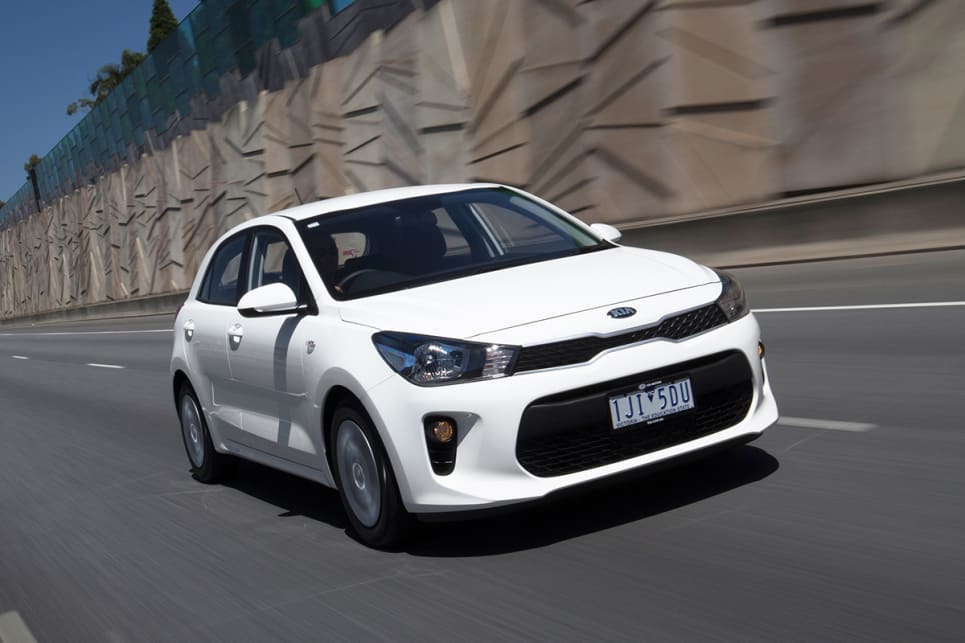
Best first hatch on a budget
- Mazda 2
- Kia Rio
- Holden Spark
- Holden Spark 2017
- Kia Rio 2017
- Mazda 2 2017
- Holden Hatchback Range
- Kia Hatchback Range
- Mazda Hatchback Range
- Hatchback
- Mazda 2 Reviews
- Kia Rio Reviews
- Holden Spark Reviews
- Holden
- Kia
- Mazda
- Urban Hacks
- Holden Advice
- Kia Advice
- Mazda Advice
- Small Cars
- Buying tips
- Urban
- Hacks

There are possibly no two more depressing words than 'car' and 'budget' when you're shopping for your first taste of automotive freedom.
Mental images of wowing your mates with some sleek and stunning beauty, or road-tripping with the stereo blasting and the convertible roof lowered, almost always give way to a cold and harsh reality, one that often consists of a clapped-out, second-hand banger serving up nothing but crackling AM radio and offering all the structural integrity of wet papier-mâché.
The good news, then, is there’s actually never been a better (or cheaper) time to buy a new car instead, and provided you’re realistic about what you can afford, you might find budget hatch shopping a far more exciting experience than you were expecting.
Things that were once entirely ignored on our cheapest cars (safety, technology, comfort) now feature in spades in Australia’s entry-level market, and you can find yourself with change from $15k for a city-sized hatch, provided you’re willing to change gears yourself.
And so here are our three favourite hatchbacks if you’re shopping on a budget.
Holden Spark LS $13,990 (manual), $15,690 (auto)

If you’re of a certain vintage, you’ll remember Holden's smallest offering as a Barina Spark, but in early 2016 this city-sized hatch became simply the Spark.
This one is designed and built in Korea (traditionally not good news for ride and handling), but Holden’s local team has tweaked the suspension and steering to suit Aussie tastes, as well as having a hand in the car’s overall design.
You can choose from exactly one engine; a surprisingly perky 1.4-litre petrol unit that will produce 73kW/128Nm, and that is partnered with a five-speed manual or, for a cost, a CVT auto. Fuel use is a cheap-to-run 5.2L/100km (manual) or 5.5L/100km (auto) on the combined cycle.
Crucial here, though, is the technology on offer. There’ll be no constantly skipping Discman in your future (though perhaps I’m showing my age there), with even the cheapest Spark fitted with a 7.0-inch screen that’ll partner with your iPhone or Android device, unlocking Spotify playlists or your own music and allowing you to use your phone’s map system for integrated satellite navigation.

As with most little-engined cars, the manual option is the pick for squeezing the most fun out of the limited power on offer, but if you’re partial to automatics, the CVT does the job just fine, too. Its biggest perk on the road is its size, with the little Spark easy to drive, easy to park and just right for navigating cramped city streets
Standard safety is something of a let down on the cheapest Spark, though, with the littlest Holden missing out on standard AEB - and even a standard reversing camera. You do, however, get dual front, front-side and curtain airbags that cover the back row, as well as stability control.
Kia Rio S $16,990 (manual) $19,090 (automatic)

Kia’s Rio is actually the brand’s best-selling car globally, but the outgoing model lacked some of the crucial technology to mix it with the segment’s best here in Australia.
This fourth-generation model, launched earlier this year, goes some considerable way to changing that. Yes, the $16,990 starting price (for a manual car, an auto will set you back more than $19k) is on the high side, but you do get plenty of cool stuff for the money.
For a start, a new 7.0-inch screen runs Apple CarPlay and Android Auto, so you can use your phone on the fly as well as tap into its music and map options. You’ll also find halogen DRLs, power windows front and rear and a genuinely appealing, European-ish body style that looks good (and not cheap) on the road.

Safety is covered by six airbags (two front, two front-side and two curtain), a reversing camera and rear parking sensors, while 'Hill Start Assist' joins two new stability systems, 'Cornering Brake Control' and 'Straight Line Stability'. AEB, however, is not available.
The real party trick here, though, is the Kia’s killer ownership story; seven-year warranty with capped price servicing throughout and service schedules pegged at 15,000km or 12 months.
The downside? While the 74kW/133Nm 1.4-litre engine can be paired with a six-speed manual (our pick), the only automatic option is an ageing four-speed unit that fails to extract the best from the engine.
Mazda2 Neo $14,990 (manual) $16,990 (auto)

It’s a bit of a mixed bag with the Mazda2 Neo, which offers plenty of design punch and the best standard safety offering of the lot, but lacks some of the on-board technology of our other contenders.
The only car to arrive with 15-inch alloy wheels as standard, the Neo is a genuinely good looking thing - compliments of Mazda’s smiley-faced Kodo design language. You'll also find power windows, air-conditioning, cruise control and keyless start on the standard features list.

Its 1.5-litre petrol engine makes 79kW/139Nm, and partners with a six-speed manual or a proper six-speed torque converter automatic transmission (though it will cost you another $2k). the result is something sailing dangerously close to fun on the road, with the Neo praised by our team for its surprisingly strong dynamic skill set.
Safety is very good, and the best of our three finalists. While this base-model car misses a reversing camera, you will find six airbags, ABS, rear parking sensors and AEB as standard.
The catch? There’s no Apple CarPlay or Android Auto, and the Neo doesn’t even have a multimedia screen to speak of, rather a thin, letterbox-style setup that can only partner with your phone via Bluetooth. So if technology is a critical component, that could be a deal breaker.








Comments